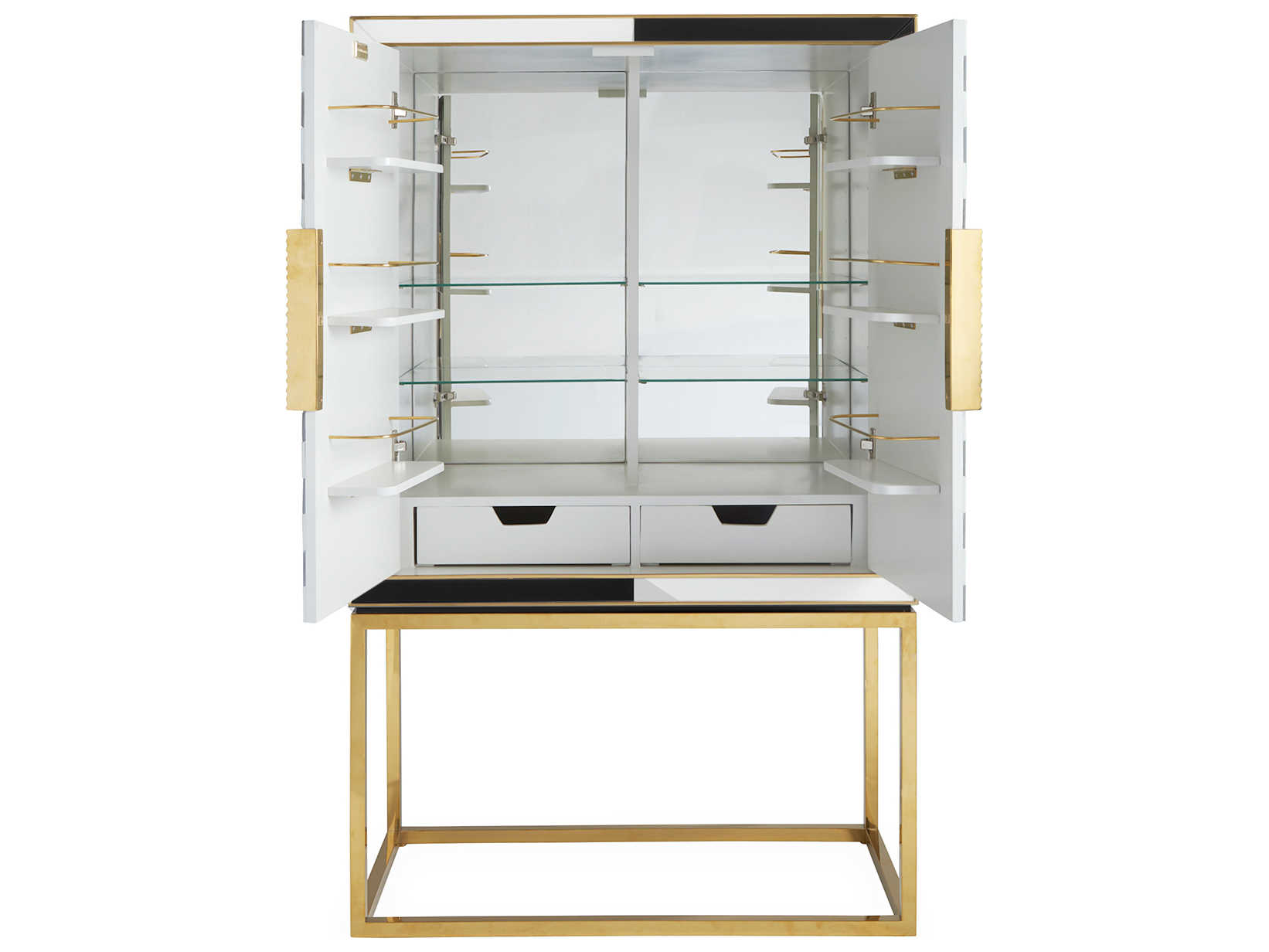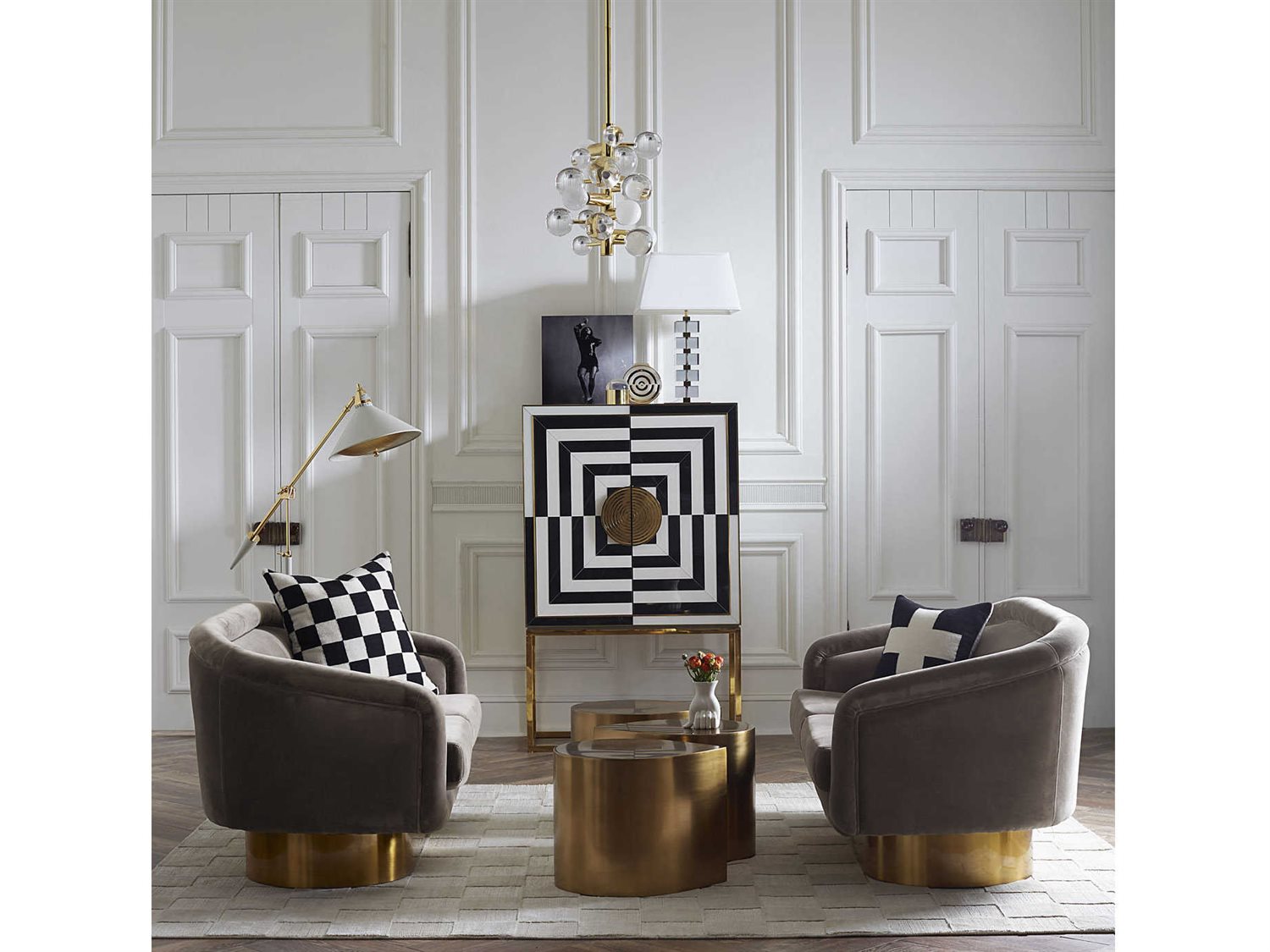Jonathan Adler Bar Cabinets: Styles & Design Elements

Jonathan Adler bar cabinets are known for their eclectic mix of mid-century modern, global influences, and a distinctly playful aesthetic. The brand offers a diverse range of styles, utilizing a variety of materials and design elements to create statement pieces for the home. This analysis will explore the range of styles, compare specific designs, and detail the typical design elements found across the Jonathan Adler bar cabinet collection.
Range of Styles and Materials
Jonathan Adler bar cabinets showcase a diverse range of styles, incorporating various materials to achieve their unique aesthetic. Common materials include lacquered wood in a variety of colors (from bold jewel tones to more muted neutrals), brass accents which frequently serve as hardware or decorative elements, and sometimes incorporate other materials such as ceramic or glass. Styles range from sleek and minimalist designs to more ornate and maximalist pieces, allowing for integration into diverse interior design schemes. The use of bold colors and graphic patterns is a recurring theme, contributing to the brand’s signature look.
Comparison of Three Distinct Designs
Three distinct Jonathan Adler bar cabinet designs illustrate the brand’s stylistic breadth. First, a lacquered wood cabinet with clean lines and brass hardware exemplifies a more streamlined, mid-century modern aesthetic. This style prioritizes functionality and a sophisticated simplicity. Second, a cabinet featuring intricate detailing, perhaps with inlaid mother-of-pearl or other embellishments, showcases a more maximalist approach, emphasizing opulence and visual richness. Finally, a cabinet with a bold geometric pattern and vibrant lacquer finish exemplifies a playful, eclectic style, reflecting a global influence. These designs, while distinct, all share the common thread of high-quality craftsmanship and a commitment to unique design.
Dimensions and Storage Capacity of Popular Models
The following table compares the dimensions and storage capacity of three hypothetical Jonathan Adler bar cabinet models, representing the range of sizes offered. Note that these dimensions are illustrative and may not correspond exactly to any specific existing model. Actual dimensions should be verified on the Jonathan Adler website or through a retailer.
| Model | Dimensions (W x D x H) | Shelf Space | Storage Capacity (approx. bottles) |
|---|---|---|---|
| Model A (Small) | 30″ x 15″ x 36″ | 2 adjustable shelves | 10-12 |
| Model B (Medium) | 40″ x 18″ x 42″ | 3 adjustable shelves + drawer | 18-24 |
| Model C (Large) | 48″ x 20″ x 48″ | 4 adjustable shelves + 2 drawers | 30-36 |
Typical Design Elements, Jonathan adler bar cabinet
Jonathan Adler bar cabinets consistently incorporate several key design elements. Hardware is frequently composed of brass, often featuring bold shapes or finishes, adding a touch of glamour and sophistication. The cabinets themselves are typically characterized by clean lines or bold geometric shapes, reflecting the brand’s design philosophy. The overall aesthetic is generally described as sophisticated yet playful, incorporating unexpected details and a vibrant color palette. The use of lacquer finishes provides a smooth, glossy surface, enhancing the visual impact of the cabinet’s shape and any decorative elements. The combination of these elements results in bar cabinets that are both functional and visually striking, serving as focal points in a variety of interior spaces.
Jonathan Adler Bar Cabinet Price & Value Proposition

Jonathan Adler bar cabinets occupy a premium segment of the home furnishings market. Their pricing reflects a combination of brand recognition, design aesthetic, materials used, and the manufacturing process. Understanding the price structure requires examining these contributing factors in relation to the perceived value offered to the consumer.
The price range of Jonathan Adler bar cabinets varies considerably depending on size, materials, and included features. Smaller, simpler designs might start around $1,500, while larger, more elaborate pieces featuring intricate detailing, exotic wood veneers, or integrated features (such as mirrored backs or specialized storage) can easily exceed $10,000. These price points are consistent with the brand’s overall positioning as a purveyor of high-end, designer home goods.
Price Comparison with Other High-End Brands
A direct comparison of Jonathan Adler bar cabinets with similar offerings from other high-end brands reveals a competitive, yet premium, pricing strategy. The following list illustrates this comparison, noting that specific models and features influence the final price.
- Jonathan Adler: $1,500 – $10,000+ (depending on size, materials, and features)
- Restoration Hardware: $1,000 – $8,000+ (often featuring more rustic or traditional designs)
- Ralph Lauren Home: $2,000 – $12,000+ (emphasizing classic elegance and high-quality materials)
- Arhaus: $1,200 – $9,000+ (offering a range of styles from modern to traditional)
These price points demonstrate that Jonathan Adler occupies a competitive space within the high-end market, often aligning with or slightly exceeding comparable offerings from other established brands. The variations reflect differences in design aesthetics, material choices, and overall brand positioning.
Manufacturing Process and Craftsmanship
The cost of a Jonathan Adler bar cabinet is significantly influenced by its manufacturing process and the level of craftsmanship involved. These cabinets are not mass-produced; rather, they are often crafted using a combination of traditional techniques and modern manufacturing methods. This typically includes:
- Material Selection: High-quality materials, such as solid wood veneers (often exotic species), polished metals, and high-end lacquers, are employed. The sourcing and processing of these materials contribute to the overall cost.
- Skilled Labor: The construction often involves skilled artisans and cabinetmakers who utilize traditional joinery techniques and hand-finishing processes. This labor-intensive approach significantly increases the cost compared to mass-produced cabinets.
- Quality Control: Rigorous quality control measures ensure that each piece meets the brand’s high standards. This process adds to the overall production time and expense.
- Design and Development: The initial design and development process, involving designers and engineers, also contributes to the final price. The unique and often iconic designs are a significant part of the Jonathan Adler brand’s value proposition.
In summary, the price of a Jonathan Adler bar cabinet reflects not just the materials used but also the extensive craftsmanship, design investment, and brand recognition associated with the product. The value proposition lies in owning a unique, high-quality piece that embodies the brand’s distinctive aesthetic and represents a significant investment in home décor.
Integrating a Jonathan Adler Bar Cabinet into Home Decor

Jonathan Adler bar cabinets, known for their distinctive aesthetic, offer a unique opportunity to elevate the style and functionality of any home. Their incorporation into existing décor requires careful consideration of the cabinet’s design elements and the overall style of the room. Successful integration hinges on creating a cohesive and visually appealing space where the bar cabinet acts as a complementary, rather than conflicting, element.
The versatility of Jonathan Adler bar cabinets allows for seamless integration across a wide range of interior design styles. Their bold designs, often featuring vibrant colors, intricate patterns, or sculptural forms, can serve as a statement piece or a subtle accent, depending on the desired effect and the surrounding décor.
Jonathan Adler Bar Cabinets in Diverse Interior Design Styles
The inherent design flexibility of Jonathan Adler bar cabinets enables their adaptation to various interior design aesthetics. For instance, a sleek, minimalist cabinet with clean lines and a neutral color palette would complement a mid-century modern setting characterized by simple forms and functionality. Conversely, a more ornate cabinet with intricate detailing and a rich color would enhance a bohemian space brimming with textures and global influences. A traditionally styled cabinet, perhaps featuring dark wood and classic hardware, could easily integrate into a formal, traditional interior.
Room Setting Examples Featuring Jonathan Adler Bar Cabinets
Setting 1: Mid-Century Modern Living Room A Jonathan Adler bar cabinet with a sleek, geometric design and brass accents is placed against a wall featuring a gallery of mid-century modern art prints. The cabinet is paired with a low-slung sofa upholstered in a neutral-toned fabric, a pair of Eames-style chairs, and a simple coffee table made of teak wood. Muted colors and clean lines create a sophisticated atmosphere. The cabinet’s brass accents subtly reflect light, enhancing the room’s ambiance.
Setting 2: Bohemian-Style Dining Room A Jonathan Adler bar cabinet with a vibrant, hand-painted design and a global-inspired motif is positioned in a dining room with a mix-and-match collection of chairs, a large woven rug, and eclectic wall art. The cabinet’s colorful surface acts as a focal point, complementing the room’s bohemian aesthetic. The overall effect is one of vibrant energy and relaxed sophistication.
Setting 3: Traditional Home Office A Jonathan Adler bar cabinet with a more subdued, traditionally styled design – perhaps featuring dark wood and polished brass hardware – is incorporated into a home office setting. It is placed alongside a large, antique writing desk, a comfortable leather armchair, and bookshelves filled with leather-bound volumes. The cabinet’s traditional styling creates a sense of timeless elegance within the professional space.
Adaptability of Jonathan Adler Bar Cabinets to Various Room Sizes and Layouts
Jonathan Adler offers a range of bar cabinet sizes, from compact pieces suitable for smaller apartments to larger, more substantial units ideal for spacious homes. Their adaptability extends to different room layouts. A smaller cabinet can easily be tucked into a corner or alcove, while a larger piece can be used as a room divider or a focal point in a larger space. Careful consideration of the cabinet’s dimensions and the available space is crucial for successful integration.
